
By Sean Kelley, Woods Hole Oceanographic Institution, Engineer
Caitlin Adams, NOAA Office of Ocean Exploration and Research, Web Coordinator
September 13, 2017
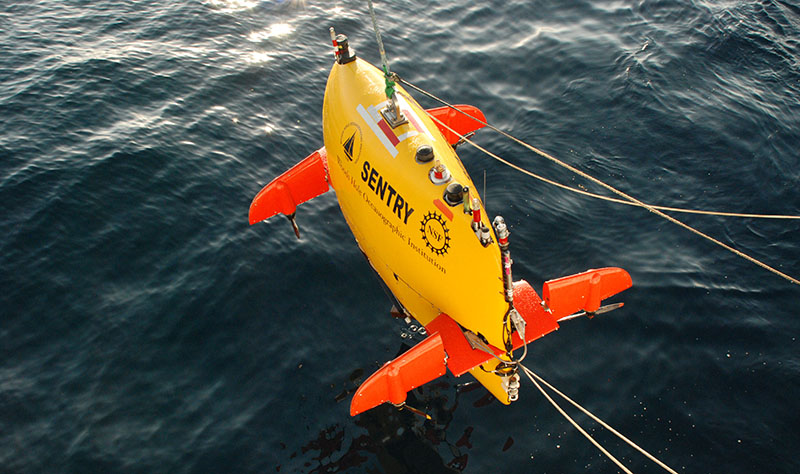
AUV Sentry was successfully deployed for the first time on September 13. It ran a 24-hour survey before being released to the surface and recovered on September 14. Image courtesy of DEEP SEARCH 2017, NOAA-OER/BOEM/USGS. Download larger version (jpg, 3.1 MB).
DEEP SEARCH is not the first cruise to use autonomous underwater vehicle (AUV) Sentry as its primary data collection tool. Last year and again immediately preceding this cruise, Martha Nizinski led the Carolina Canyons project aboard NOAA Ship Pisces.
As a fisheries science vessel (FSV), the Pisces does not typically spend its time running AUV operations. So when the first Sentry project was assigned to the FSV last year, the ship’s crew and the Sentry team had to work together to figure out how to launch and recover the vehicle—and, even more importantly, track the vehicle while it’s in the water.
Though Sentry’s engineers are able to pre-program the AUV’s track before launch, it’s important to know where Sentry is whenever it’s in the water, to ensure that it’s operating as planned and that no complications have occurred. Sentry uses ultra-short baseline, or USBL, as its primary tracking system (for a detailed explanation of how USBL tracking works, revisit last year’s mission log). The Sentry system used on board the Pisces is a Sonardyne Ranger2, which can be used to track the AUV to its maximum depth of 6,000 meters. This system can be mounted on an over-the-side pole system or to the ship’s centerboard.
Last year, the over-the-side pole method was used to track Sentry. It’s typically the easier method to use on ships that do not regularly deploy submersibles, as it can be temporarily installed during mobilization for a cruise and removed when the cruise ends. However, this does require quite a bit of setup for each cruise, and deploying the USBL pole over the side for dives can be time consuming and not always successful in less-favorable conditions. Last year, the Carolina Canyons team used the over-the-side pole and faced lots of operational challenges trying to track Sentry in high current environments that were constantly disrupting the pole (read more here).
This year, we’ve opted for a centerboard-mounted USBL system. The ship’s centerboard is a retractable keel that can be lowered from the hull and is equipped with acoustic transducers that allow researchers to collect data away from hull-generated noise. By mounting the Sentry USBL transducer on the centerboard, we know it will have more stability and allow us to operate more assuredly in higher-current environments like the Gulf Stream. Such an installation is certainly not an easy process, though. NOAA Office of Ocean Exploration and Research, Pisces, and Sentry representatives spent many hours planning the installation together, and at least five technicians were needed to make the installation a reality, weeks before Carolina Canyons set sail.
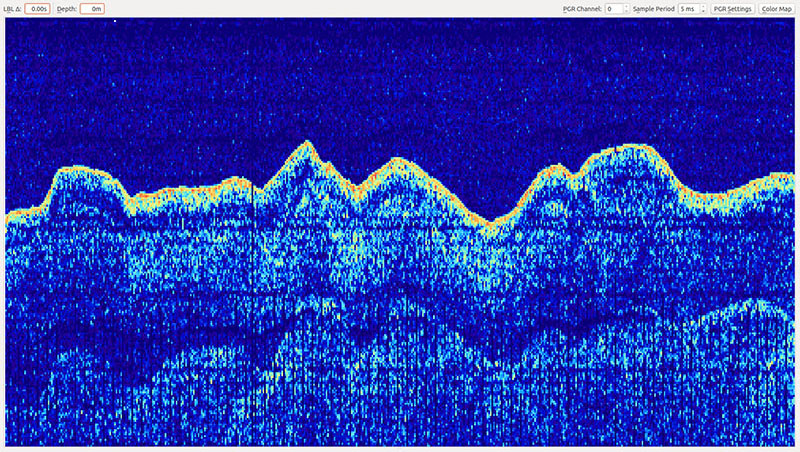
While Sentry primarily uses USBL (ultra-short baseline), it also uses a subset of a long baseline positioning system to determine the slant range to the vehicle. The ship sends a ping at 10.5khz, and Sentry replies with a 11.5khz ping that the ship decodes to display the acoustic signature of the sound in the water. During Sentry deployments, a waterfall display of the return ping is plotted, which gives the watchstander an idea of what the vehicle is doing—i.e., moving away from the ship, moving toward the ship, descending, ascending, or making a turn in a survey. Image courtesy of AUV Sentry, Woods Hole Oceanographic Institution. Download larger version (jpg, 3 MB).
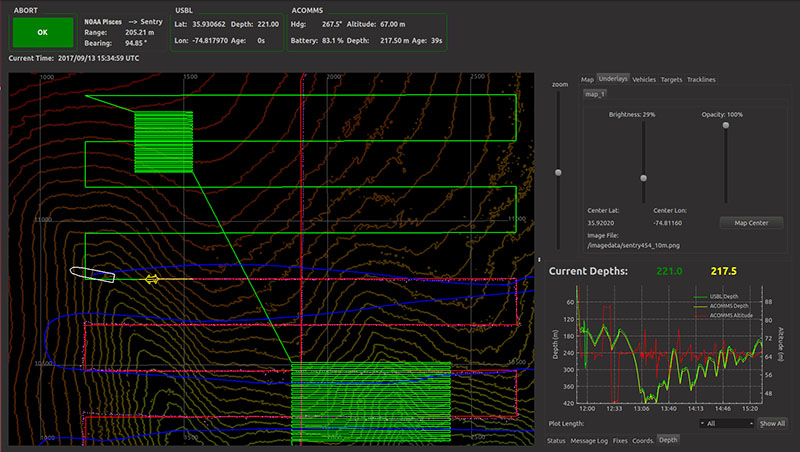
This navigation display shows almost all of the information Sentry engineers need to know that the vehicle is completing its survey properly. The green line shows the programmed track for the survey—here, long, continuous paths mean Sentry was collecting mapping data while the snake-like box path lines mean the Sentry was taking photos. Completed tracks are shown in red. The Sentry, represented in yellow, can be seen midway through its mapping survey, with the ship, in white, just ahead of it. Image courtesy of AUV Sentry, Woods Hole Oceanographic Institution. Download larger version (jpg, 1.2 MB).
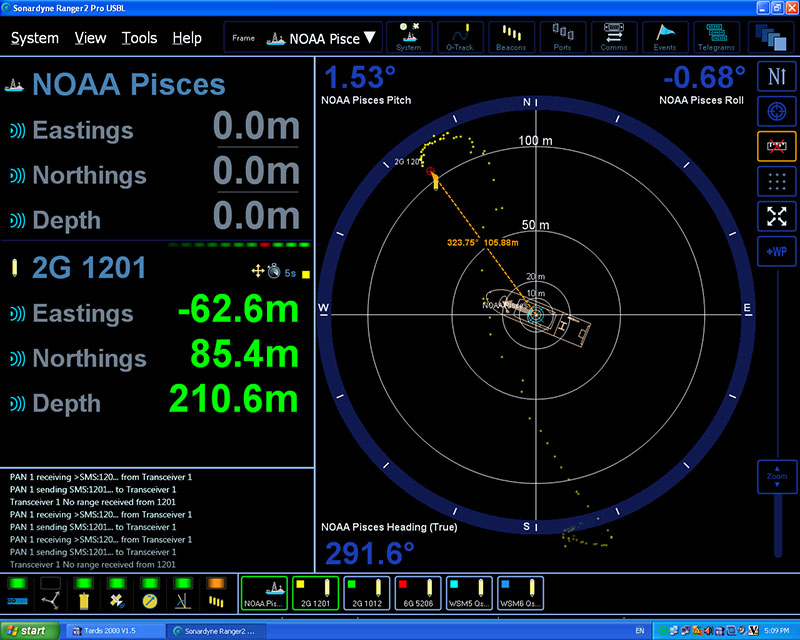
Another navigation display used by the Sentry team, this Sonardyne Ranger2 display shows the relative positions of the ship and the Sentry. Here, the Pisces was maintaining position while Sentry continued its survey just 105 meters away. Image courtesy of AUV Sentry, Woods Hole Oceanographic Institution. Download larger version (jpg, 696 KB).
During our DEEP SEARCH cruise, USBL tracking and navigation will still be challenging though because we are targeting a number of shallow sites (less than 500 meters). In shallow water, the echoes of the tracking beacon and transceiver can get confused and cause poor navigation. Moreover, the ideal place to track the AUV from the ship is directly on top of the AUV — but having the ship directly on top of the AUV at such a shallow depth is not suggested, as you need to keep a safe watch circle away in case the AUV aborts and rises to the surface.

AUV Sentry engineers Andy Billings and Jennifer Vaccaro remove Sentry’s cradle so that it can be safely lifted by the ship’s crane and deployed in the water. Image courtesy of DEEP SEARCH 2017, NOAA-OER/BOEM/USGS. Download larger version (jpg, 5.5 MB).
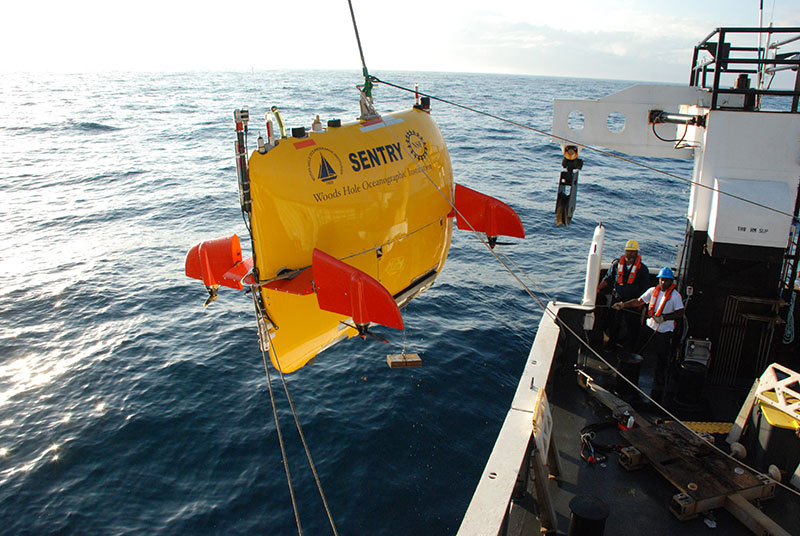
The Pisces deck crew and the Sentry engineers work together to hold the taglines seen here connected to the Sentry. The taglines are used to steady the Sentry while the crane lifts it off the deck and over to the water. Image courtesy of DEEP SEARCH 2017, NOAA-OER/BOEM/USGS. Download larger version (jpg, 5.5 MB).
Even so, things are going well so far. We’ve had one successful Sentry dive, where the ship ably navigated at a close but safe distance while the Sentry was in the water. Once we get the over-a-terabyte of data downloaded, we will begin the process of sorting through the multibeam imagery, water column data, and photos collected!